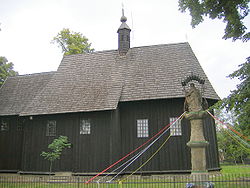Wojnicz
| Wojnicz | ||
|---|---|---|

Wooden church in Wojnicz
|
||
|
||
| Coordinates: 49°58′N 20°50′E / 49.967°N 20.833°E | ||
| Country |
|
|
| Voivodeship | Lesser Poland | |
| County | Tarnów | |
| Gmina | Wojnicz | |
| Established | tenth century | |
| Town rights | 1278-1934, 2007 | |
| Government | ||
| • Mayor | Jacek Kurek | |
| Area | ||
| • Total | 8.50 km2 (3.28 sq mi) | |
| Population (2007) | ||
| • Total | 3,404 | |
| • Density | 400/km2 (1,000/sq mi) | |
| Time zone | CET (UTC+1) | |
| • Summer (DST) | CEST (UTC+2) | |
| Postal code | 32-830 | |
| Area code(s) | +48 14 | |
| Car plates | KTA | |
| Website | http://www.wojnicz.pl | |
Wojnicz [ˈvɔi̯ɲit͡ʂ] is a town in Tarnów County, Lesser Poland Voivodeship. In the early times of the Polish state, it used to be one of the most important centers of the province of Lesser Poland. The Battle of Wojnicz took place here on September 23, 1655, against Sweden.
Wojnicz is located on the boundary of two geographic regions of Poland - the Sandomierz Basin, and the Western Carpathians. The largest river of the area is the Dunajec, which flows east of the town, between Wojnicz and the nearby city of Tarnów. Wojnicz does not have a rail station, but is located at the intersection of the European route E40, and local route number 975 from Dąbrowa Tarnowska to Nowy Sącz. The town has a sports club Olimpia, founded in 1947.
Wojnicz is one of the oldest urban settlements of southern Lesser Poland. First Slavic settlers appeared here in the 8th or 9th century, and Wojnicz emerged as a grod, where warriors of local princes lived. According to a legend, some time in the late 10th century, warriors (Polish: wojowie) of either Mieszko I or his son Bolesław I Chrobry built here a military stronghold, called Wojnicz to honor them. In 1217, the town was called Woynicze. In 1224, its name was spelled Woyniz, and in 1239 - Woynicz. Polish language specialists Kazimierz Rymut and Stanisław Rospond claim that the name Wojnicz comes from the last name Wojna, which was then changed to Wojnice, Wojnic, and finally - Wojnicz.
Wojnicz as a fortified military stronghold emerged some time in the 10th century, and in 1109, the Church of Saint Lawrence was built here, probably on initiative of Prince Bolesław III Wrymouth, as a votum for victory in the Battle of Nakło. In the 12th century, Wojnicz became the seat of a castellan, it also had a street market. In 1239, after Princess Kinga of Poland was engaged to Bolesław V the Chaste at Wojnicz, the settlement probably was granted town rights, though no documents have been preserved to confirm this. In 1278, it is for the first time mentioned as a town, with a defensive wall. In 1379, the town burned in a fire, and in 1381, upon order of King Louis I of Hungary, Wojnicz became the seat of a county in Sandomierz Voivodeship. It remained one of major urban centers of Lesser Poland, and on September 13, 1394, Queen Jadwiga of Poland visited the town. In 1465, collegiate school was opened, and a Gothic style parish church was built. Twenty years later, the town burned in a fire.
...
Wikipedia


